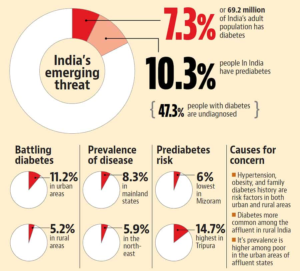Diabetes
Diabetes is a chronic disease that occurs when the pancreas is no longer able to make insulin, or when the body cannot make good use of the insulin it produces.
80%
of people with diabetes live in low- and middle income countries.
101M
India, once known as the ‘diabetes capital of the world’ is home to 101 million patients
92.3M
India is second only to China which is home to 92.3 million diabetics.

Insulin is a hormone made by the pancreas, that acts like a key to let glucose from the food we eat pass from the blood stream into the cells in the body to produce energy. All carbohydrate foods are broken down into glucose in the blood. Insulin helps glucose get into the cells.
Not being able to produce insulin or use it effectively leads to raised glucose levels in the blood (known as hyperglycaemia). Over the long-term high glucose levels are associated with damage to the body and failure of various organs and tissues.
Diabetes mellitus, a major lifestyle disease is undoubtedly the most challenging public health problem of 21st century with a worldwide prevalence of 388 million (8.3%) and predicted to be 592 million by 2035.
Although worrisome statistics, considering the inherent variability in biological phenomenon and widespread interventions for control of disease, these estimated extrapolations and predictions may prove tentative in relation to the potential burden that diabetes may impose upon the country.
Indians have a peculiar genetic composition and Asian Indian phenotype that predisposes them to have higher propensity to metabolic syndrome, diabetes mellitus and coronary artery disease.

Indians characteristically have increased insulin resistance, greater abdominal adiposity (higher waist circumference despite lower body mass index), higher prevalence of impaired glucose tolerance, lower adiponectin and higher high sensitive C-reactive protein levels; contributing to a greater risk of developing disease at a relatively younger age.
Additionally epidemiological transition, economic boom, physical inactivity, trendy dietary patterns and environmental factors also add to this risk. Indian healthcare professionals and patients in India face a number of challenges such as clinical inertia in achieving glycemic control, inadequate follow-up and lack of disease awareness.
Do you know 422 Million adults have Diabetes!

The International Diabetes Federation estimated a doubling of diabetic population between 1995 and 2005, and predicted 70 million diabetics by 2025.
The World Health Organization predicted a 50% increase in deaths from diabetes over next 10 years.
By 2030, diabetes is projected to be the seventh leading cause of death
1.6 million deaths are directly caused by diabetes
- Gynaecological symptoms including pelvic pain, abnormal bleeding and bloating
- Breast lumps and breast pain with same-day ultrasound
- Hormone testing with blood results. Pregnancy blood testing with results
